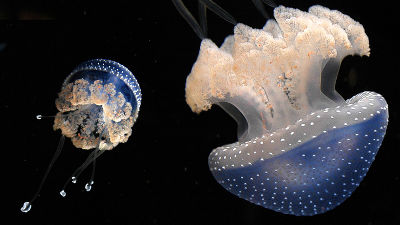It turned out that the jellyfish thought to be gentle to humans was actually firing a `` capsule with a venom needle '' from the tentacle

Some of the jellyfish drifting To fluffy the sea emits a Dokuhari
Cassiosomes are stinging-cell structures in the mucus of the upside-down jellyfish Cassiopea xamachana | Communications Biology
https://www.nature.com/articles/s42003-020-0777-8
Stinging Water Mystery Solved – “Mucus Grenades”
https://scitechdaily.com/stinging-water-mystery-solved-mucus-grenades/
Sasa jellyfish that live in tropical mangrove forests are symbiotic with algae. Algae photosynthesize with the carbon dioxide emitted by Sasa jellyfish and sunlight, and Saka jellyfish receives nutrients generated by algae photosynthesis, but in an environment where photosynthesis is not sufficient, Sasa jellyfish needs to eat Need to prey on other animals.
Cassiopea xamachana, which the research team paid attention to this time, is a kind of jellyfish, and it is generally regarded as 'non-stabbing jellyfish'. However, there was a case where a diver who swam around Cassiopea xamachana drifted reported 'skin tingling'.

by prilfish
When the research team observed the mucus released by Cassiopea xamachana, they found a small stab cell capsule. The research team has named this capsule ' Casiosome ' from its scientific name.
Casiosomes are hollow spheres, which are filled with translucent and gel-like substances that make up the body of jellyfish called “mesoglea”, and with symbiotic algae. The cells that make up the sphere are sting cells, some of which have cilia , and the casiosomes can move in water. In addition, three types of toxins were detected from sting cells.
The team observed Cassiopea xamachana's tentacles and found that when the jellyfish was stimulated, countless casiosomes were released from the tentacles. The diver's skin was tingling because he was not stabbed directly with the tentacles of Cassiopea xamachana, but instead was stabbed by the 'capsule with a venomous needle' released by Cassiopea xamachana.
The following movie shows where Artemia was put into Cassiopea xamachana's aquarium. When Artemia is put in, gently shake the aquarium to stimulate Cassiopea xamachana, and in just one minute, you can see that most of Artemia has been immobilized by the poison of the Casiosome.
Brine Shrimp Succumbing to Balls of Stinging Cells From Jellyfish-YouTube
'I don't know much about jellyfish poisons,' said the co-author of the paper, 'This study reveals one of the most interesting and novel ways to use jellyfish poison.' It's now. '
`` The existence of jellyfish has been known for more than 200 years, but the presence of the casiosome has not been known before, '' said Allen Collins, the creator of the research project and a zoologist at the U.S. Agency for Oceans and Atmosphere. The findings are particularly exciting, 'commented,' Cassiopea xamachana is not a particularly toxic creature, but it does affect human health. '
Related Posts:







